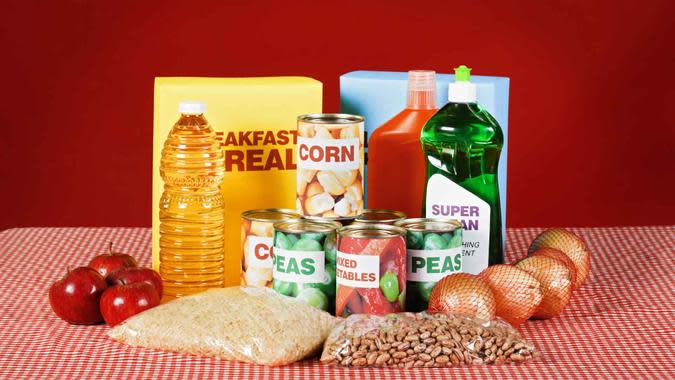Save Money the Healthy Way: 8 Diet Tips To Improve Your Well-Being and Wallet

Unfortunately, eating healthier often runs counter to cutting your grocery spending. Food prices are still stubbornly high, and a diet rich in fruits, vegetables and healthy proteins inevitably costs more than one with calorie-dense carbs and processed meats.
Check Out: 6 Ways Living Frugally Creates a Richer Life
Read Next: 6 Genius Things All Wealthy People Do With Their Money
So, how can you get back to better health without breaking the bank? By being conscientious with what you buy and what you consume. Here are eight dieting tips for eating healthy on a budget.

1. Water, Water, Water!
That boring, flavorless liquid is the closest thing living creatures have to a cure-all. Water allows the body to perform a near-endless list of important functions that maintain health, including improving circulation and mental performance.
And talk about cheap! Although you’ll pay pennies for municipal drinking and bottled water, most liquids and food sources have trace-to-significant amounts of H2O. While it is possible to drink too much water, experts recommend four to eight cups a day.
Learn More: 6 Things Minimalists Never Buy — and You Shouldn’t Either
For You: Frugal People Love the 6 to 1 Grocery Shopping Method — Here’s Why It Works

2. Plan Your Meals
Efficiency is key to a healthier and cheaper diet. Meal prepping can become an organizational obsession, but simply planning healthy meals and stretching your money for the week can help keep you on track — and save you potentially hundreds of dollars a month.
As Healthline suggested: “Make sure to also scan your fridge and cabinets to see what you already have. You may have foods hidden in the back that can be used, or you may want to plan your meals around foods you need to use before they expire.”
Explore More: Average Cost of Groceries Per Month — How Much Should You Be Spending?

3. Make a Shopping List …and Stick to It!
Sticking to a shopping list can make your trips to the grocery store fast and easy, eliminate impulse buys and reduce your food wastage. You should be only shopping for the items you need and you’ve listed. A full 85% of participants in Ramsey Solutions’ National Study of Millionaires — those who can afford to spend more freely — rely on a grocery list to some degree.
Additionally, don’t shop when you’re hungry. There’s a tendency for people who haven’t eaten to choose more high-calorie foods when they’re supermarket strolling. Shoppers who are hungry and don’t have a list have a tendency to steer their carts toward the junk food aisle.

4. Buy Generic Products Over Name Brands
You may be being conned. While brand name products are pushed into your psyche through every available media source, generic groceries are close to the same quality as their popular brand counterparts — but cost about 40% less. In fact, many products are made by the more expensive competition brands and disguised as “phantom brands,” per The Conversation.

5. It’s Okay To Buy Canned or Frozen
There’s no way around it: Healthy eating means including fruits and vegetables — essential for overall nutrition and to support a strong immune system — in your daily diet. Local produce that’s in season is preferable to out-of-season options, but perishables have short shelf lives and can be expensive, too.
You can rely on canned and frozen staples to last longer and push your dollar further than fresh options. However, make sure to read labels diligently (which you should be doing anyway). You’ll lose little nutritionally if you stay away from added sugar and salt.
Be Aware: Food Stamps — 4 Major Changes to SNAP Coming in 2024

6. Eat Less Often?
Diet fads come and go and certain regimes work for certain people. One trend that never goes out of style is eating less. It’ll save you money, but is cutting out meals healthy? Everyone is different, so make sure to research any food slashing diet.
For example, nutrition expert Dr. Eric Berg promotes a one meal a day diet (OMAD) as the path to better physical and financial health. This fasting strategy involves eating the number of calories you need for an entire day during a one-hour eating window and spending the remaining 23 hours abstaining from food. Berg believes you can save at least $600 a month using the OMAD method, while also bringing about a host of health benefits.

7. Grow Your Own Food
Growing your own fruit and veg can be a cost effective way of getting healthy. While it pays to know what you’re doing, even a novice gardener with a small patch can achieve the twin goals of getting healthy and saving cash.
Aside from some up-front costs, you could save over $600 a year by growing fresh produce, depending on the size of your operation, per Money.

8. Couponing Is King!
Over the past few years, the term “extreme couponing” has entered our retail lexicon. But you don’t have to go overboard to save serious money and stay healthy using discounts. According to a CouponFollow study, the average U.S. household could save $1,465 per year using coupons.
There’s so much material available to thrifty shoppers and deals to be had cutting paper coupons and using coupon collector apps. Start with The Krazy Coupon Lady site, which has a wealth of resources that will help you save time and money. You’ll be surprised how much you can save by regularly using coupons at the store and online if you stick to what you’ll consume.
This article originally appeared on GOBankingRates.com: Save Money the Healthy Way: 8 Diet Tips To Improve Your Well-Being and Wallet




